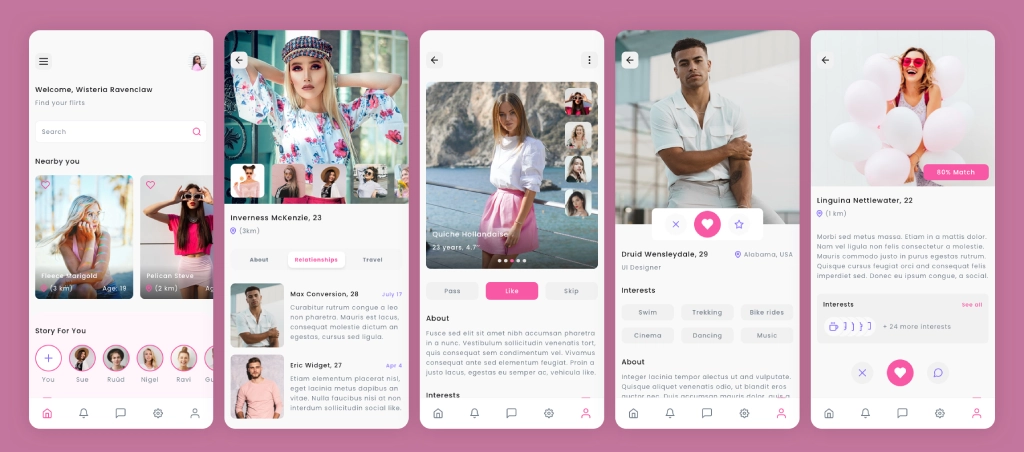Table of Contents
ToggleDating has changed, and so have relationships.
Not everyone is looking for just one partner. Some people are exploring polyamory, open relationships, or simply want to connect with others who understand their unique relationship style.
That’s where dating mobile apps like PolyFinda come in. It’s a space made for people who value honesty, consent, and connection, beyond traditional relationship rules.
So, what if you had an idea to build your own polyamorous dating mobile app?
One that welcomes ethical non-monogamy, supports LGBTQ+ communities, and helps people find meaningful relationships, on their terms.
Good news: you can.
This comprehensive guide will help you understand the blueprint for developing your own polyamory-friendly dating mobile app, from features and tech stack to cost and monetization, so that you can stand out in a growing world of non-monogamous dating platforms.
Let’s get started.
Step-by-Step Guide to Building a Dating Mobile App Like PolyFinda
Building a polyamorous dating mobile app requires careful planning, the right features, and an inclusive user experience.
Below is a step-by-step breakdown to help you create the next best LGBTQ dating mobile app for trans people that supports open relationships, polyamory, and diverse identities.
Step 1: Define Your Niche and USP
To build a successful polyamorous dating mobile app, start by clearly defining your niche.
Are you creating a platform for polyamorous couples, the queer community, or those exploring open relationship dating mobile apps?
Your Unique Selling Proposition (USP) is what will set your app apart as the best LGBTQ dating app in India or a go-to hub for non-monogamous dating.
You need to focus on offering:
- Gender and relationship diversity
- Safe spaces for LGBTQ+ users
- Verified profiles with visible pronouns
A clear niche and USP help you attract the right audience and build a trusted, inclusive community.
Step 2: Define Core Features and Must-Have Functionality
After defining your niche, it’s time to focus on the core features in your mobile app development process that will make your dating mobile app stand out as a trusted polyamorous dating mobile app or even the next best LGBTQ dating app.
Your polyamorous-friendly dating mobile apps should prioritize inclusivity, consent, and community.
Some of the key features to include:
| Feature | Description |
| Multiple Partner Profiles | Allow users to link or manage profiles with partners. |
| Consent-First Messaging | Enable chats only after mutual interest to promote respectful interactions. |
| LGBTQ+ Inclusive Filters | Provide filters based on gender identity, orientation, and relationship types. |
| Safe Chat Spaces | Support end-to-end encrypted messaging and in-app reporting tools. |
| Event Listings & Forums | Help users find local meetups and join discussions within the community. |
| Multi-Profile Options | Useful for users in open or non-monogamous relationships to manage multiple dynamics. |
To increase the user experience, consider integrating AI and machine learning. AI can suggest better matches, detect harmful content, and personalize event or profile recommendations, making your polyamory relationship mobile app smarter and safer for everyone.
These features create a space where users feel understood, safe, and empowered to connect authentically.
Step 3: Choose a Scalable Tech Stack
To build a reliable and high-performing poly dating mobile app, you need a tech stack that can support real-time chat, geo-matching, media uploads, notifications, and rapid scaling.
Here’s how to choose the right tools for each part of your mobile app:
1. Frontend (React Native or Flutter): React Native is ideal for building a dating app like PolyFinda because it lets you develop for both Android and iOS with a single codebase.
This speeds up mobile app development and keeps the experience consistent across devices. It’s perfect for real-time features like chat and swiping, and easily integrates with tools like geolocation and push notifications, making it a strong choice for scalable polyamorous dating mobile apps.
2. Backend (Node.js, Django, or Ruby on Rails): Your backend handles user authentication, profile management, matchmaking logic, and data exchange.
Node.js offers great performance for real-time mobile apps, while Django and Ruby on Rails are known for rapid mobile development and security.
3. Database (PostgreSQL or MongoDB): Choose PostgreSQL for structured data (like user profiles and preferences) or MongoDB for more flexible, document-style data (like messages or dynamic forms). Both are scalable and secure.
4. Real-time Messaging (Firebase or Pusher): These tools help power live chat features, push notifications, and activity updates. They are essential for any dating mobile app where instant communication matters.
5. Cloud Hosting (AWS, Google Cloud, or Azure): These platforms provide reliable infrastructure for your dating mobile app, ensuring 24/7 uptime, automatic scaling, and global access.
6. AI/ML Integration (Optional): If you want to add smart features, then AI can power personalized match suggestions, detect inappropriate content, or recommend events based on user interests.
You can use tools like Google Cloud AI or AWS SageMaker to make integration easy.
By choosing the right combination of tools, you are setting your app up for smooth performance, quick development, and future growth, everything a polyamorous-friendly dating mobile app needs to succeed.
Step 4: Design an Inclusive UI/UX
A thoughtful and inclusive design makes users feel safe and respected, especially in polyamorous-friendly dating mobile apps and LGBTQ+ inclusive apps.
Use clear, inclusive language, allow users to express their identity freely, and avoid gendered visuals or assumptions. Accessibility should also be a core part of your design, ensuring the app works well for all users, including those with disabilities.
Here’s a quick look at what to focus on:
| Design Element | What to Include |
| Language | Gender-neutral terms, pronoun options, and non-assumptive profile fields |
| Visual Design | Neutral color palettes, modern layouts, and avoiding overly gendered themes |
| Profile Customization | Identity, orientation, and relationship-style flexibility (e.g., polycules) |
| Accessibility | Readable fonts, high-contrast text, screen reader support, keyboard navigation |
| Navigation & UX | Simple, intuitive flow with easy access to safety tools and privacy settings |
When designed right, your dating mobile app becomes more than a dating tool; it becomes a safe, inclusive space that celebrates every user’s identity and relationship choice.
Step 5: Build the MVP
Before building a full-featured dating mobile app, start with a Minimum Viable Product (MVP), a simple, functional version of your app that includes only the most essential features.
This allows you to test your idea, gather feedback from early users, and make improvements without investing too much upfront.
For a polyamorous dating mobile app, your MVP should focus on core features that enable safe connections, inclusive profiles, and basic communication.
Here are the key components your MVP should include:
| MVP Feature | Description |
| Profile Creation | Let users set up profiles with pronouns, relationship types, identity, and orientation. |
| Matching Algorithm | Match users based on preferences, location, and shared interests. |
| Messaging & Notifications | Allow users to chat, receive real-time updates, and block/report if needed. |
| Community Features | Include basic event listings, discussion forums, or group chats to build a sense of community. |
Starting with an MVP helps you validate your concept, attract early adopters, and evolve based on real user needs, especially in niche spaces like polyamory, ethical non-monogamy, and LGBTQ+ relationships.
Step 6: Integrate Privacy, Consent & Safety Features
When building a dating app, especially one that supports polyamory, open relationships, and the LGBTQ+ community, user safety, privacy, and consent must be built into the core experience.
Your dating mobile app should be a space where people feel secure while expressing their identities and relationship choices.
Here’s how to make that happen:
- Privacy Controls: Let users decide who sees their profile, personal details, or online status.
- Consent-First Messaging: Allow chats only after mutual interest to prevent unwanted messages.
- Safety Tools: Include block/report buttons, profile verification, and user moderation features.
- Community Standards: Set clear rules for respectful interaction and take quick action on abuse.
- AI-Powered Protection: Use AI to flag harmful content, spam, or unsafe behavior in real time.
By prioritizing these features, your app can become a trusted space for users exploring non-monogamous dating platforms and a safe LGBTQ dating app in India that truly supports its community.
Step 7: App Testing and Deployment
Your app is ready, then it’s time to make sure it works smoothly before going live. Think of this phase as the final rehearsal before the big show.
Here’s what you need to focus on:
- Functionality Testing: Make sure core features like profile setup, chat, swiping, filters, and event listings work as expected.
- Cross-Device Testing: Test on different screen sizes (phones and tablets) for both iOS and Android.
- Security Checks: Protect user data with strong encryption, especially for chats and personal details.
- Performance Testing: Ensure smooth performance under different loads; no one likes a laggy dating app!
- User Feedback Loop: Gather insights from beta testers and improve based on their experience.
- App Store Deployment: Launch on Google Play and the App Store with optimized descriptions and visuals.
- Post-Launch Monitoring: Track crashes, bugs, and reviews to make quick updates.
A smooth, well-tested launch builds user trust and gives your dating app a solid start in the competitive world of non-monogamous dating platforms and safe LGBTQ dating apps.
Also Read: How much does it cost to build a dating mobile app like PolyFinda?
How to Earn Money from Your Dating Mobile App
Once your polyamorous dating mobile app is live and attracting users, it’s time to explore how you can generate revenue without compromising user trust or experience.
Here are a few proven and ethical monetization strategies you need to consider:
1. Freemium Model: Offer core features for free, while unlocking premium tools like advanced search filters, read receipts, and exclusive event access through paid subscriptions. This helps you grow your user base while monetizing power users.
2. In-App Purchases: Let users buy optional upgrades like profile boosts, visibility highlights, or digital gifts. These microtransactions allow users to stand out and engage more effectively.
3. Paid Events: Host virtual meetups, local gatherings, or workshops, and sell event tickets. This works well in mobile apps focused on polyamory or LGBTQ+ communities, where in-person or group engagement is part of the experience.
4. Ad Integration: Partner with ethical, relevant brands to show non-intrusive ads that align with your community, like LGBTQ+ services, wellness apps, or inclusive relationship tools.
With these monetization strategies, you can turn your dating app into a profitable, community-driven platform while keeping it accessible, safe, and user-friendly.
Why Choose Alphaklick to Build Your Dating Mobile App?
Your dating mobile app idea deserves more than just code; it needs a team that understands community, connection, and modern relationship dynamics.
At Alphaklick, we don’t just develop apps, we build platforms that bring people together. As a trusted React Native mobile app development company in India, we blend technology with empathy to create smooth, secure, and inclusive mobile experiences. From custom feature development to AI integration and scalable infrastructure, our mobile app developers are here to make your mobile app user-loved and launch-ready.
So if you are building for polyamory, open relationship dating mobile app, or for the LGBTQ+ community, we know how to translate your vision into reality.
You can book a free consultation call with our team today, and let’s start designing the future of dating, your way.

